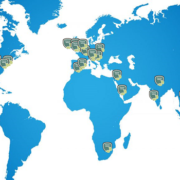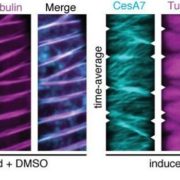
Welcome 2017-2018 Plantae Fellows
Blog, Careers, Careers - Blog, Education, Research, Research BlogWe're delighted to welcome our newest class of Plantae Fellows, selected from an outstanding pool of applicants. This year's Plantae Fellows span from Graduate Student to Professor, and come from many countries and states, from Western Australia and Vietman in the east to California in the west. They…

Clipping Chlamy Genes: Improved Methods for Targeted Gene Editing in Chlamydomonas
Blog, Research, Research Blog, The Plant Cell, The Plant Cell: In BriefA beam of sunlight sends Chlamydomonas reinhardtii scrambling. This tiny, biflagellate alga senses light with its eyespot and adjusts its movements accordingly, depending on photosynthetic needs. In the eyespot, a membranous structure of reddish, carotenoid-filled granules that reflect light and two…

Making Connections: MAC Function in Splicing and MicroRNA Biogenesis
Blog, Research, Research Blog, The Plant Cell, The Plant Cell: In BriefFans of the television show The Magic Schoolbus might remember that the teacher/heroine, Ms. Frizzle used to tell her students “Your job, as scientists, is to look for connections!” Ms. Frizzle would love the Mos4-associated Complex (MAC), because MAC has connections all over the place. Indeed, research…

Recognizing featured Plant Cell first authors: Vera Gorelova
Blog, Research, Research Blog, The Plant Cell, The Plant Cell: Author ProfilesVera Gorelova is the featured first author of Dihydrofolate Reductase/Thymidylate Synthase Fine-tunes the Folate Status and Controls Redox Homeostasis.
Current Position: PhD candidate at Ghent University looking for a new challenge
Education: MSc. In Biology, Novosibirsk State University, Russia
Non-scientific…

Recognizing featured Plant Cell first authors: Rene Schneider
Blog, Careers, Careers - Blog, Research, Research Blog, The Plant Cell, The Plant Cell: Author ProfilesRene Schneider, featured first author of Two Complementary Mechanisms Underpin Cell Wall Patterning during Xylem Vessel Development
Current Position: Postdoctoral Researcher and Lecturer at the University of Melbourne, Australia.
Education: PhD (2013) Bio-Physics, Dresden University of Technology,…

Proliferate at Your Own Risk: Ribosomal Stress and Regeneration
Blog, Research, Research Blog, The Plant Cell, The Plant Cell: In BriefPlant growth and development are extremely adaptable to changes in the external environment, including nutrient status, light quality and intensity, and temperature. Thanks to their developmental plasticity, plants can also initiate new organs from differentiated tissue following wounding, to the benefit…

Stop the Clock: Optimized Carbon Fixation and Circadian Rhythm in a CAM Plant
Blog, Research, Research Blog, The Plant Cell, The Plant Cell: In BriefThe energetically costly tendency of the carbon fixing enzyme RuBisCO to, every now and then, fix oxygen instead of carbon dioxide has led to the evolution of various carbon concentrating mechanisms in plants and algae. One such mechanism, Crassulacean acid metabolism (CAM), involves primary CO2 fixation…

A Phloem Protein Contributes to Aphid Resistance and Heat Stress Tolerance
Blog, Research, Research Blog, The Plant Cell, The Plant Cell: In BriefAphids are highly destructive insect pests—in addition to robbing plants of sugar-rich phloem sap, they carry viruses that can be deadly to the plant. To reach the phloem sap, aphids must penetrate the plasma membrane of sieve elements. Mature sieve elements, which are virtually empty, translocate…

Evidence for Two Distinct Stages in Secondary Cell Wall Formation of Xylem
Blog, Research, Research Blog, The Plant Cell, The Plant Cell: In BriefA hallmark of xylem development is the deposition of secondary cell wall material in specific patterns (reviewed in Patrick et al, 2007). These cell wall deposits structurally reinforce the xylem to withstand negative pressure during water transport and differ in different xylem cell types. While it…

